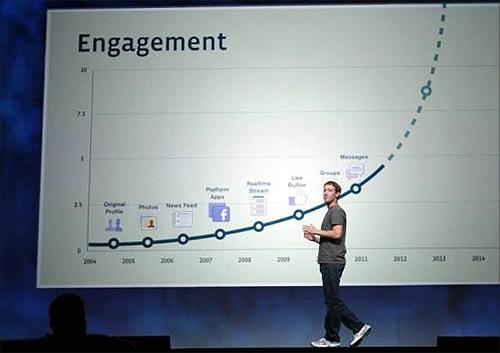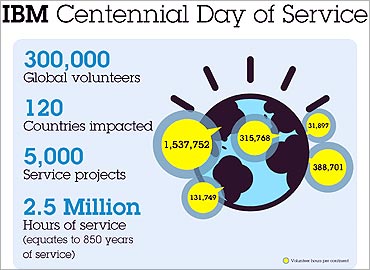
Advances in technology are enabling students and professionals to make slide presentations more appealing, engaging and effective.
Right from marketing trainees to CEOs, making a slide presentation or what is commonly known as a PPT, is an inevitable task for professionals, today.
Chief Ministers use them to entice corporate bigwigs to invest in the development of their states while fund raisers use them to impress potential donors.
PPT is like Bisleri
Microsoft's PowerPoint or PPT is just one tool used to create slide presentations, just like Bisleri is one brand of bottled mineral water. Today, other programmes like Apple's Keynote and Open Office's Impress offer many features to help less tech-savvy users make dazzling presentations.
Websites like www.prezi.com and www.brainshark.com offer a platform to make and enhance them. Besides text and images, you can even incorporate audio and animation!
A knowledge sharing tool
It's evident from websites like Slideshare.net that presentations are made by people in all five continents. Considered to be the Youtube of slide presentations, you can view a mind-boggling variety of them posted by professionals from all walks of life.
According to Slideshare, around 50,000 presentations get uploaded every week, of which the best ones are featured on the homepage. You can post comments, follow subscribers and rate presentations on diverse domains like business, finance, education and technology.
It's no wonder that millions of people visit websites like Slideshare to research on various topics ranging from social media and medicine to marketing and IT.
Multiple purposes
Slide presentations can be utilised in two ways -- as a support tool when making a verbal presentation to a live audience or as a document of communication that can be e-mailed to potential clients, partners and others.
While management graduates have a bit of an edge as their curriculum requires them to make slide presentations on a regular basis, others usually learn this skill on the job.
Here are some pointers to make your slide presentation effective, engaging and aesthetically sound.
Please click NEXT to continue reading

The first step is to determine your audience, which will in turn determine the content of your PPT.
For example, making a convincing pitch to market your company's products to college students would be quite different from making a presentation on India's economy to your boss.
Consider these questions, when creating the content:
The answer to these questions would naturally form the content for your PowerPoint slides.

It is advisable to choose from template options in the initial stages before you go to designing your own slide's background designs.
Use company colours and logos to customise.
Pick easy-to-read fonts like Arial, Tahoma and Verdana. Carefully select font sizes for headers and text. They should be consistent across the slides.
There should be ample space to communicate "key highlights" under each section. Avoid using sentences, communicate pictorially using few key words.
The design of the slide must NOT restrict your message. Slide programmes like Microsoft PPT offer different formats for slides depending on usage: depict charts and graphs or just a running text.

Consistently use the same font face and sizes on all slides, especially the title, sub-headings and text.
Use matching colours especially the background colours and text.
It is advisable to use your company logo, corporate colours, and baseline for a standard template upon which you can design each slide.

Use contrasting colours. In case the background is a rich colour, then use a light colour for text.
Highlight key insights and findings with colour.
Don't weaken the colour effect by using too many colours on each slide.
Match colours for design and contrast it well to highlight your message.

The rule is "Keep it straight and simple" when you key in the contents for each slide.
Keywords only. No sentences!
In case you are making a verbal presentation, never read your slides. Talk naturally and in your own words because the slide is a visual element that supports your speech. If there is a duplication, your audience will tend to be distracted.
So narrate an anecdote, explain the data, and decipher the graphs and charts.
Abhisek from PPTsalon says, "If you want to write paragraphs then it's better to open a Word document." PPTsalon is a design company focused on making presentations. Based in Goa, their clients comprise Fortune 500 companies, start-ups, film-makers, and even Ivy League professors.
"Never put what you're going to say on the slide. People read much faster than you can speak," adds Abhisek. So craft messages on the template slides carefully.

The few slides can express a conclusion. You can summarise key findings and propose a plan of action.

As they say, a picture can convey a thousand words.
Hence, photographs, illustrations, using symbolic images, can help in driving home the message faster and your audience can visualise the impact of what you are saying. However, use images judicially, not just for the sake of it.
If you don't have your own images, browse Flickr or Google's image search. However, ensure that you select pictures or cliparts that are for free access and not those under copyrights.

As you experiment with more presentation formats, you can even use animation and voice-overs to get your point across. But perhaps, at the beginner's level you can avoid them.

Since slides are just visual tools, it's your speech that will make an impression.
Knowing your slides inside out will also help.
Don't speak too fast and maintain eye contact with your audience as they create a connection.

Besides being used as visual aids, slide presentations are also used to disseminate useful information and are e-mailed as standalone documents.
For instance, a company may have an introductory slide presentation, which can be used to woo prospective clients or partners.
It can feature the company's profile, services, strategies, portfolio and top reasons why you must choose this company over another.
Hence the content and presentation must be comprehensive and persuasive enough to grab eyeballs and get you a meeting.
The number of slides can be more as compared to verbal presentation.
As your subject knowledge expands and you gain more experience at work, your slide presentation skills will also get that much sharper.
It's a good practice to regularly visit websites such as Slideshare and Scribd for inspiration, ideas and trends and post your presentations for knowledge sharing and feedback.
Illustration: Uttam Ghosh
With inputs from Merril Diniz